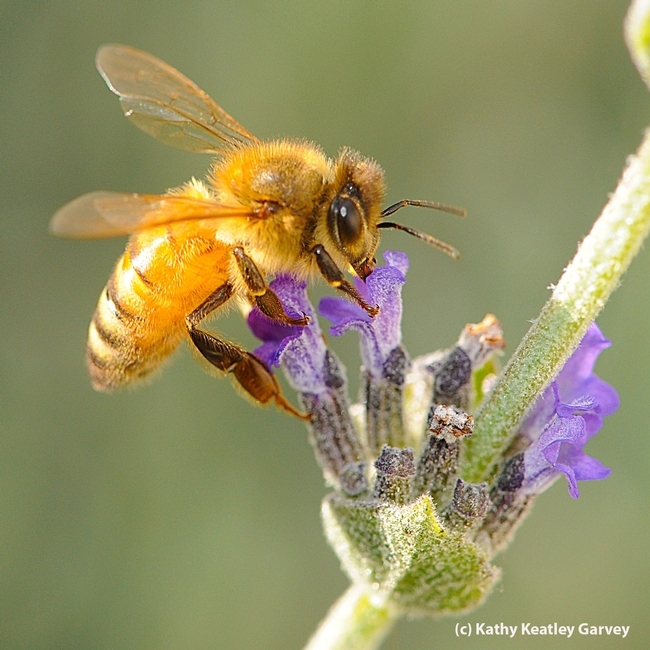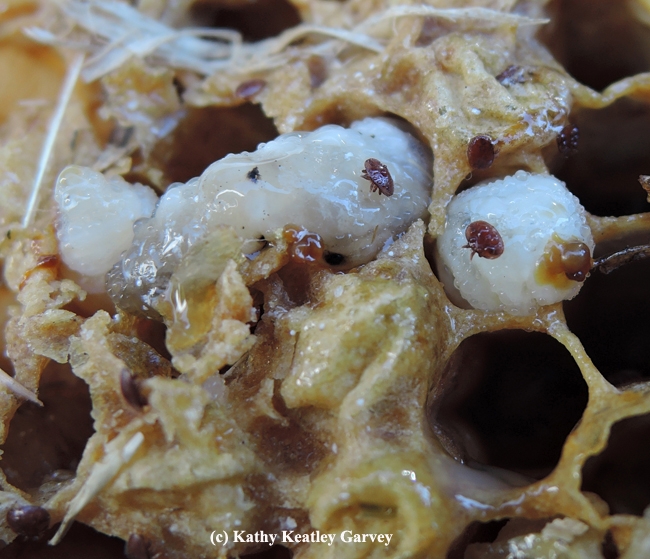It's time to revisit "The 13 Bugs of Christmas."
You've heard "The 12 Days of Christmas," beginning with a single "partridge in a pear tree" and ending with "12 drummers drumming." In between: two turtle doves, three french hens, four calling birds, five gold rings, six geese-a-laying, seven swans-a-swimming, eight maids a'milking, nine ladies dancing, 10 lords-a-leaping, and 11 pipers piping.
But have you heard "The 13 Bugs of Christmas?"
Back in 2010, Extension apiculturist Eric Mussen of the UC Davis Department of Entomology (now the UC Davis Department of Entomology and Nematology) and yours truly came up with a song about "The 13 Bugs of Christmas." Presented at the Department of Entomology's holiday party, it drew roaring applause. Then U.S. News featured it when reporter Paul Bedard picked it up.
It's still making the rounds, via tweets.
"The 13 Bugs of Christmas" is about a psyllid in a pear tree, six lice a'laying, 10 locusts leaping and 11 queen bees piping. Beekeepers know that distinctive sound of a queen bee piping.
"We attempted to keep the wording as close as possible for ‘The 12 Bugs of Christmas' and then we opted to spotlight some new agricultural pests in the next stanza," said Mussen, an Extension apiculturist with the department since 1976 who writes the bimonthly from the UC apiaries newsletter. He will be retiring in June 2014.
The song:
On the first day of Christmas, my true love gave to me, a psyllid in a pear tree.
On the second day of Christmas, my true love gave to me, two tortoises beetles and a psyllid in a pear tree
On the third day of Christmas, my true love gave to me, three French flies, two tortoise beetles and a psyllid in a pear tree
On the fourth day of Christmas, my true love gave to me, four calling cicadas, three French flies, two tortoise beetles and a psyllid in a pear tree
On the fifth day of Christmas, my true love gave to me five golden bees, four calling cicadas, three French flies, two tortoise beetles and a psyllid in a pear tree
On the sixth day of Christmas, my true love gave to me six lice a'laying, five golden bees, four calling cicadas, three French flies, two tortoise beetles and a psyllid in a pear tree
On the seventh day of Christmas, my true love gave to me seven boatmen swimming, six lice a'laying, five golden bees, four calling cicadas, three French flies, two tortoise beetles and a psyllid in a pear tree
On the eighth day of Christmas, my true love gave to me eight ants a'milking aphids, seven boatmen swimming, six lice a'laying, five golden bees, four calling cicadas, three French flies, two tortoise beetles and a psyllid in a pear tree
On the ninth day of Christmas, my true love gave to me nine mayflies dancing, eight ants a'milking aphids , seven boatmen swimming, six lice a'laying, five golden bees, four calling cicadas, three French flies, two tortoise beetles and a psyllid in a pear tree
On the tenth day of Christmas, my true love gave to me 10 locusts leaping, nine mayflies dancing, eight ants a'milking aphids, seven boatmen swimming, six lice a'laying, five golden bees, four calling cicadas, three French flies, two tortoise beetles and a psyllid in a pear tree
On the 11th day of Christmas, my true love gave to me 11 queen bees piping, 10 locusts leaping, nine mayflies dancing, eight ants a'milking aphids, seven boatmen swimming, six lice a'laying, five golden bees, four calling cicadas, three French flies, two tortoise beetles and a psyllid in a pear tree
On the 12th day of Christmas, my true love gave to me 12 deathwatch beetles drumming, 11 queen bees piping, 10 locusts leaping, nine mayflies dancing, eight ants a'milking aphids, seven boatmen swimming, six lice a'laying, five golden bees, four calling cicadas, three French flies, two tortoise beetles and a psyllid in a pear tree
Knowing the agony that Californians experience with the seemingly unending flood of pests, Mussen felt it "bugworthy" to add this verse:
"On the 13th day of Christmas, Californians woke to see:??13 Kaphra beetles,?12 Diaprepes weevils,?11 citrus psyllids,?10 Tropilaelaps clareae,?nine melon fruitflies,?eight Aedes aegypti,? seven ash tree borers,?six spotted-wing Drosophila,?five gypsy moths,?four Japanese beetles,?three imported fire ants,?two brown apple moths,?and a medfly in a pear tree."
Mussen, who retired this year after 38 years of service, noted that "Tropilaelaps clareae" is a honey bee mite from Asia, as is the well-known Varroa mite (Varroa destructor), which was first detected in the United States (Wisconsin) in 1987 and is now beekeepers' No. 1 problem.
It's unlikely, however, that "Tropilaelaps clareae" and "Varroa destructor" will become part of any other Christmas song...but you never know...
Attached Images:

